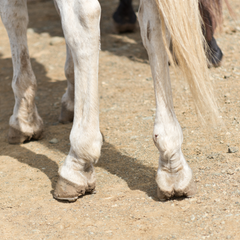Edema in horses is the accumulation of fluid somewhere in their bodies, most commonly in their legs (commonly known as “stocking up”) or in their lower abdomen. Edema is different than inflammation and, in rare cases, can become malignant and even fatal. Read on to learn about common forms of edema in horses and what you can do to help.
Retained Fluid + Lymphatic Drainage
Horses have a robust lymphatic system with about 8,000 lymph nodes throughout their bodies (compared to the human lymphatic system with only 400-600). The lymphatic system is responsible for detoxing lymphatic fluid from arterial blood pushed out into the surrounding tissues. The horse’s lymphatic system is slow and is greatly aided by their movement (which is why you might have had a trainer recommend walking for a stocked-up horse!).
Horses can retain fluid in more than just the legs and lower abdomen, including the sheath (for geldings and stallions), as well as the lower jaw or cheek.
Causes of Equine Edema

Because the equine lymphatic system depends so much on movement, edema is often the direct result of a horse standing still for long periods of time. A plan for daily movement is vital for a stabled horse. You’ll also want to keep movement in mind while traveling to avoid any unnecessary lymphatic fluid build-up in your horse. An allergic reaction, infection, or trauma response in the body can also cause edema.
Stocking Up of the Legs
Edema of the legs—most often referred to as “stocking up”—is the most common form of edema in horses. While some horses may be more prone to it, the most straightforward treatment is to get your horse to start moving. To increase circulation in your horse’s legs and harmonize bodily functions safely and naturally, we recommend Benefab® Therapeutic Polo Wraps for exercise or Benefab® Therapeutic VersiWraps for stall and pasture rest. This will also help tackle any inflammation or achiness in the legs.
Lower Abdomen Edema
Second to stocking up, edema in the lower abdomen of the horse is very common, mainly because gravity pulls the excess fluid to the lowest part of your horse’s midsection. Again, simple movement is the go-to treatment, but many horse owners find lymphatic drainage massage to be very effective as well. Many horse owners opt for the Benefab® Rejuvenate SmartScrim to increase circulation in their horse’s bodies as well, as the medical-grade magnets non-invasively pull the horse’s blood to circulate over predetermined acupuncture points with prolonged therapeutic effects even after the SmatScrim is removed.
Is Edema the Same as Inflammation?
No, edema is built-up lymphatic fluid in your horse, whereas inflammation is your horse’s immune system responding to an irritant or foreign stimulus. Inflammation is often accompanied by pain, whereas edema can be pressed without a pain reaction and will feel doughy to the touch.
What is Malignant Edema in Horses?
Malignant edema is the rarest form of edema and is marked by infection, loss of appetite, fever, and swelling around a specific injury site. Malignant edema in horses is the fatal spread of bacterial toxins in the bloodstream. It is caused by the infection of Clostridium septicum bacteria in an incision, injury, or tearing at birth. While early intervention with antibiotics and surgical drainage can cure malignant edema, the survival rate is about 40% in horses, as the disease moves quickly.






















